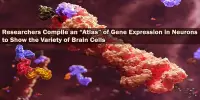Scientists from the University of Sydney and Fudan University have shown that human brain signals traverse the outer layer of neural tissue in ways that naturally organize themselves into spiral patterns.
The study, which was published today in Nature Human Behaviour, shows that these pervasive spirals, which are cortical brain signals seen in both the resting and thinking states, assist in structuring mental activity and cognitive processing.
Senior author Associate Professor Pulin Gong, from the School of Physics in the Faculty of Science, said the discovery could have the potential to advance powerful computing machines inspired by the intricate workings of the human brain.
The finding brings up fresh perspectives on how the brain functions and offers insightful information about its core operations. Examining their functions may aid medical researchers in better comprehending the impacts of brain disorders like dementia.
“Our study suggests that gaining insights into how the spirals are related to cognitive processing could significantly enhance our understanding of the dynamics and functions of the brain,” said Associate Professor Gong, who is a member of the Complex Systems research group in Physics.
“These spiral patterns exhibit intricate and complex dynamics, moving across the brain’s surface while rotating around central points known as phase singularities.”
“Much like vortices act in turbulence, the spirals engage in intricate interactions, playing a crucial role in organising the brain’s complex activities.”
“The intricate interactions among multiple co-existing spirals could allow neural computations to be conducted in a distributed and parallel manner, leading to remarkable computational efficiency.”
In our research we observed that these interacting brain spirals allow for flexible reconfiguration of brain activity during various tasks involving natural language processing and working memory, which they achieve by changing their rotational directions.
Yiben Xu
PhD student Yiben Xu, the lead author of the research from the School of Physics, said the location of the spirals on the cortex could allow them to connect activity in different sections, or networks, of the brain acting as a bridge of communication. Many of the spirals are large enough to cover multiple networks.
The cortex of the brain, often referred to as the cerebral cortex, is the brain’s outermost layer and is in charge of a variety of intricate cognitive processes, including consciousness, language, perception, memory, and attention.
“One key characteristic of these brain spirals is that they often emerge at the boundaries that separate different functional networks in the brain,” Mr. Xu said.
“Through their rotational motion, they effectively coordinate the flow of activity between these networks.”
“In our research we observed that these interacting brain spirals allow for flexible reconfiguration of brain activity during various tasks involving natural language processing and working memory, which they achieve by changing their rotational directions.”
The scientists gathered their findings from functional magnetic resonance imaging (fMRI) brain scans of 100 young adults, which they analysed byadapting methods used to understand complex wave patterns in turbulence.
In order to understand how the brain works, neuroscience has typically concentrated on interactions between neurons. To better understand the mysteries of the brain, there is a growing body of science that examines the broader processes that occur inside.
“By unravelling the mysteries of brain activity and uncovering the mechanisms governing its coordination, we are moving closer to unlocking the full potential of understanding cognition and brain function,” Associate Professor Gong said.
















